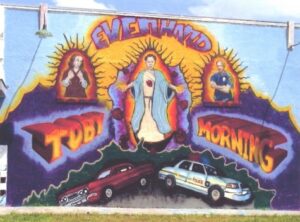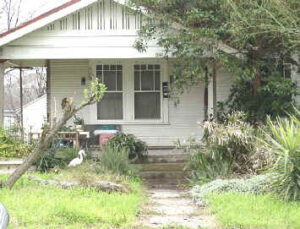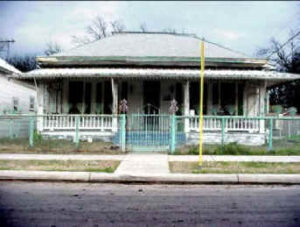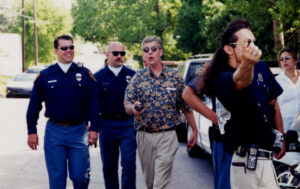
The final mural image
EXT. LAWN — DAY
Scene #21R
EXT. FRANCIS’ HOUSE — DAY
Scene #98
EXT. COP’S HOUSE #1 — DAY
Scene #99
EXT. COP’S HOUSE #2 — DAY
Scene #100
EXT. MURAL STREET — DAY
Scene #101
I saw candidates for the Belligerent Man yesterday at the crack house. What a motley assortment of humanity! One guy was about 65 — not ideal for someone Bill Sage would be repeatedly throwing to the ground and roughly handcuffing. Another guy was 6’4″ and soap opera beautiful. Not what I had in mind for a white trashy guy hanging out on a lawn drinking beer out of a paper bag. After exhausting the small talent pool assembled for my scrutiny I looked around the set and noticed Roger Eickenroht, one of the grips. He was kind of scruffy (as we all were by then) and not too old or too big, but obviously in good shape. I asked him if he wanted to be a day player in the film, with the understanding that he would be subject to considerable manhandling during the scene. He deliberated for a few moments and said he was game.
Those of you who have read this production journal from the beginning (you’re my favorites) will remember that the belligerent man scene was originally shot on our first day of production, the Day from Hell. The journal entry for that day explains in great detail what went wrong that caused us to be in the position of re-shooting the scene today.
The difference in the first day and today was striking. First and foremost, the guy I’ve called “Sammy,” the long-gone Stunt Coordinator, was, well, long gone. We accomplished several stunt-like scenes since his departure convincingly for the camera and without any injury to actor or crew. This one was probably the most involved; Officer Morning chases a belligerent man across several lawns, then tackles him and cuffs him in a single smooth action. He jumps up like a cowboy and shouts “What’s my time? I knew I should have been a cowpoke!”
One of the biggest problems the first time we attempted this scene was conflict between Sammy and Tim & I on how to block the scene. To prevent a repeat of that conflict, Tim and I met last night in the Liberty Bar and I scrawled a shot list on a stained paper napkin whilst we sipped our cocktails. First thing in the morning we taped the napkin to the back of the camera. We solemnly consulted the tiny scrawled water-stained diagrams as necessary throughout the morning. Not our usual way of working, but we were making a statement of some sort.
Today was another one of those days where we had to make a choice on the “look” of the scene — sun or clouds. We had a little of each all morning, so either way there would be a fair amount of waiting around. Tim and I decided on the cloudy look. Before each take there was a five to ten minute wait for a new little bunch of clouds.
Bill Sage and Roger rehearsed the stunt on a furniture blanket until they were both familiar with the action and confident in their ability to pull it off. We did one final rehearsal for camera and it went perfectly. Bill got the handcuffs on Roger almost instantaneously.
I think we ended up doing 13 takes altogether. I was compelled to keep shooting because Bill never quite got the cuffs on as fast as he had in that last rehearsal. I was seduced into thinking that the next take would be the perfect one. Roger and Bill both assured me they could have done more, but I finally quit before someone got hurt unnecessarily. On reviewing the takes later, several were good enough for us to believe Morning’s dialogue.

The house I assigned to Hodge
Next we did a series of shots of Francis (Bill Dawes) on his way to Morning’s funeral. Francis drives his patrol car to a couple of different cop’s houses to pick up other officers, all of whom wear their dress uniforms. I had to pick three other cops for the scene, so I chose the three SAPD officers who were my favorites for their natural ability as actors (and storytellers) and who had each become a friend during the making of EvenHand: Richard Hodge, Kenny Hagen and Michael Ross. All three are featured in several other scenes in the film.

Francis’ house (pre-landscaping)
We arrived at Francis’ house first. The set dressers were still working on the lawn and sidewalks. Since we were doing just fine on time, we hung out and watched them furiously chopping away at the turf. I don’t know whose house this was, but they got a pretty damn good deal from us; we paid them a location fee and then our crew spent all day edging and mowing their lawn and trimming shrubs. It looked mighty fine when those sweaty boys were done.

Kenny Hagen’s house
As we were filming one of these shots of Billy D. driving up to a house, Tim asked me why I chose such crappy houses for the cops of San Lovisa to live in. The question surprised me, but it also made me articulate why I changed my original plan of choosing more middle class homes for the cops. I grew to love the weird old houses of the East side of town where we concentrated so much of our filming to the point where I couldn’t bear to have our cops live anywhere else. It seemed right to me that they would be part of the same curious old neighborhood in which our story unfolds.
The final scene of the day was the bear: the funeral procession. Fernando and I spoke frequently throughout production about this scene. On the one hand we couldn’t afford many vehicles. On the other, it was meant to be the beginning of a slain officer’s funeral procession, so it had to look pretty impressive. Fernando had asked me several times if I wanted a hearse, but I couldn’t really justify the expense, so I always said “no,” even though I really did want one. He figured out how to get me one anyway. Transpo also scared up several additional decommissioned police cars, bringing our total to about ten cars. Not bad.
Then, a remarkable thing happened. All the police officers on set started making phone calls and before long we had assembled some thirty police vehicles, including several Bexar County Sheriff’s Dept. cars and eight motorcycles for an escort. Sweet.

The scene was awesome, but a logistical nightmare to organize. I drove one of our patrol cars down Pine Street until Tim, at camera, couldn’t see it. This became the start mark for the procession. Then, after some wrangling with the AD department, I had all the vehicles line up behind that first car. On action, they all began to roll down the street toward camera, all lights flashing. Like any shot with so many variables, we tweaked as we went along, but I was always mindful that each additional take meant resetting thirty-odd vehicles by sending them around a 12 block square. I was also keeping in mind that the cops who showed up to help us out did so as a favor and when they got bored or called to duty, they were likely to simply leave.
Take 1: the procession was too slow, the cars were too far apart and the camera needed to pan later to catch more of the procession as it approached. I asked Tim to pan with Francis’ patrol car, the one immediately after the hearse. Reset and wait.
Take 2: tighter, but still kind of slow, and a gawker vehicle stopped in the middle of the street, blocking the camera’s view of the dramatic approach. NG. Tighten up the traffic lock-up and reset again.
Take 3: the slate was not in frame enough. Tim called “Second sticks.” I said, “Forget it, the cars are already coming.” New slate boy sticks the slate in anyway. Tim says, “Still too low, third sticks.” I say “NO! It’s going to mess up the shot!” New slate boy sticks the slate in again. Perfect slate this time, but the shot is ruined as the procession is well in frame by now. I say “God damn it! CUT!” It’s the first time on the entire shoot that I lost my shit and it felt pretty good. I then told Tim to pretend to be filming the patrol cars as they passed so the cops didn’t think we were just goofing off while they burned county gas. Reset yet again.
Take 4: pretty good, but the guy with the sign that ends the shot didn’t come into frame quite early enough. I gave him a new cue. Reset the cars.
Take 5: nice all around. No reason to test the patience of thirty odd cops, so we wrap.
The guy with the sign paces in front of the completed mural, now transformed into a memorial to Toby and Morning. His sign reads “I am a liar.”
– Joseph Pierson




